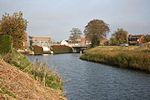Littleworth railway station
Disused railway stations in LincolnshireFormer Great Northern Railway stationsPages with no open date in Infobox stationRailway stations in Great Britain closed in 1961Railway stations in Great Britain opened in 1848 ... and 1 more
Use British English from August 2015

Littleworth railway station is a former railway station in Deeping St Nicholas, Lincolnshire, on the Peterborough to Lincoln Line. It opened in 1848 and was closed for passengers in 1961.Some of the station buildings and goods shed are still standing and are used as commercial premises. The line is still open and is used by passenger services between Peterborough, Spalding and Lincoln.
Excerpt from the Wikipedia article Littleworth railway station (License: CC BY-SA 3.0, Authors, Images).Littleworth railway station
Littleworth Drove, South Holland Deeping St. Nicholas
Geographical coordinates (GPS) Address External links Nearby Places Show on map
Geographical coordinates (GPS)
| Latitude | Longitude |
|---|---|
| N 52.721 ° | E -0.2123 ° |
Address
Littleworth
Littleworth Drove
PE11 3EN South Holland, Deeping St. Nicholas
England, United Kingdom
Open on Google Maps










